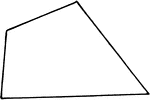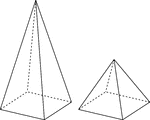
2 Right Rectangular Pyramids
Illustration of 2 right rectangular pyramids with hidden edges shown. The rectangular bases are congruent,…
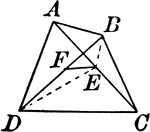
Quadrilateral With Diagonals and Midpoints Joined
Quadrilateral with intersecting diagonals and segment connecting midpoints.

Axis of Symmetry Drawn on a Quadrilateral
Illustration of an axis of symmetry drawn with respect to a quadrilateral.
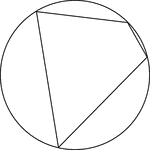
Cyclic Quadrilateral
Illustration of a cyclic quadrilateral, a quadrilateral inscribed in a circle. This can also be described…
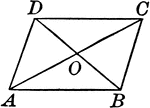
Quadrilateral With Diagonals
Illustration to show that if the diagonals of a quadrilateral bisect each other, the figure is a parallelogram.
Quadrilaterals With Lines Joining Midpoints
Illustrations to show quadrilaterals with lines joining the midpoints of the sides of any quadrilateral,…
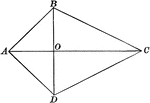
Quadrilateral with Symmetry
Illustration of a quadrilateral which has two adjacent sides equal and the other two sides equal. It…
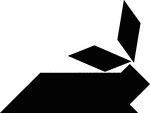
Rabbit Lieing Down
Tangrams, invented by the Chinese, are used to develop geometric thinking and spatial sense. Seven figures…
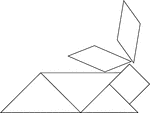
Rabbit Lieing Down
Tangrams, invented by the Chinese, are used to develop geometric thinking and spatial sense. Seven figures…
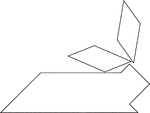
Rabbit Lying Down
Tangrams, invented by the Chinese, are used to develop geometric thinking and spatial sense. Seven figures…
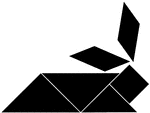
Rabbit Lying Down
Tangrams, invented by the Chinese, are used to develop geometric thinking and spatial sense. Seven figures…

Rabbit Siting on Its Hind Legs
Tangrams, invented by the Chinese, are used to develop geometric thinking and spatial sense. Seven figures…

Rabbit Siting on Its Hind Legs
Tangrams, invented by the Chinese, are used to develop geometric thinking and spatial sense. Seven figures…

Rabbit Siting on Its Hind Legs
Tangrams, invented by the Chinese, are used to develop geometric thinking and spatial sense. Seven figures…

Rabbit Siting on Its Hind Legs
Tangrams, invented by the Chinese, are used to develop geometric thinking and spatial sense. Seven figures…
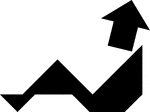
Reclining Man Facing Left
Tangrams, invented by the Chinese, are used to develop geometric thinking and spatial sense. Seven figures…
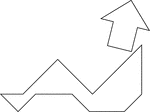
Reclining Man Facing Left
Tangrams, invented by the Chinese, are used to develop geometric thinking and spatial sense. Seven figures…

Reclining Man Facing Left
Tangrams, invented by the Chinese, are used to develop geometric thinking and spatial sense. Seven figures…

Reclining Man Facing Left
Tangrams, invented by the Chinese, are used to develop geometric thinking and spatial sense. Seven figures…
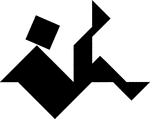
Reclining Man Facing Right
Tangrams, invented by the Chinese, are used to develop geometric thinking and spatial sense. Seven figures…
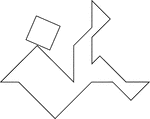
Reclining Man Facing Right
Tangrams, invented by the Chinese, are used to develop geometric thinking and spatial sense. Seven figures…

Reclining Man Facing Right
Tangrams, invented by the Chinese, are used to develop geometric thinking and spatial sense. Seven figures…
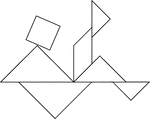
Reclining Man Facing Right
Tangrams, invented by the Chinese, are used to develop geometric thinking and spatial sense. Seven figures…

Rectangle
Tangrams, invented by the Chinese, are used to develop geometric thinking and spatial sense. Seven figures…

Rectangle
Tangrams, invented by the Chinese, are used to develop geometric thinking and spatial sense. Seven figures…

Rectangle
Tangrams, invented by the Chinese, are used to develop geometric thinking and spatial sense. Seven figures…

Rectangle
Tangrams, invented by the Chinese, are used to develop geometric thinking and spatial sense. Seven figures…

Rectangle With Diagonals
Illustration to show that if the diagonals of a parallelogram are equal, the figure is a rectangle.
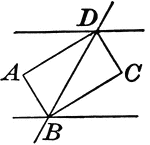
Rectangle Formed When Two Parallel Lines are Cut by a Transversal
Illustrations to show that if two parallel lines are cut by a transversal, the bisectors of the interior…

Rectangular Pyramid Cut By Plane
Illustration of a right rectangular pyramid that has been cut by a plane parallel to the base. The lower…
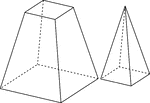
Rectangular Pyramid Cut By Plane
Illustration of a right rectangular pyramid that has been cut by a plane parallel to the base. The top…

Rectangular Pyramid Cut By Plane
Illustration of a right rectangular pyramid that has been cut by a plane parallel to the base. The top…

Rectangular Pyramid Cut By Plane
Illustration of a right rectangular pyramid that has been cut by a plane parallel to the base. The lower…
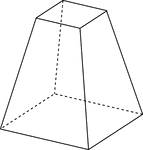
Frustum Of A Rectangular Pyramid
Illustration of a right rectangular pyramid that has been cut by a plane parallel to the base. The top…

Frustum Of A Rectangular Pyramid
Illustration of a right rectangular pyramid that has been cut by a plane parallel to the base. The top…
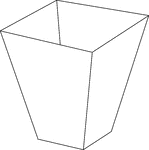
Frustum Of A Rectangular Pyramid
Illustration of a right hollow rectangular pyramid that has been cut by a plane parallel to the base.…
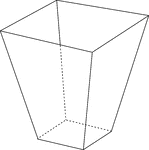
Frustum Of A Rectangular Pyramid
Illustration of a right hollow rectangular pyramid that has been cut by a plane parallel to the base.…

Popcorn Box Frustum Of A Rectangular Pyramid
Popcorn box that is in the shape of a frustum of a rectangular pyramid.

Rhombus
Tangrams, invented by the Chinese, are used to develop geometric thinking and spatial sense. Seven figures…

Rhombus
Tangrams, invented by the Chinese, are used to develop geometric thinking and spatial sense. Seven figures…

Rhombus
Tangrams, invented by the Chinese, are used to develop geometric thinking and spatial sense. Seven figures…

Rhombus
Tangrams, invented by the Chinese, are used to develop geometric thinking and spatial sense. Seven figures…

Right Triangle
Tangrams, invented by the Chinese, are used to develop geometric thinking and spatial sense. Seven figures…

Right Triangle
Tangrams, invented by the Chinese, are used to develop geometric thinking and spatial sense. Seven figures…

Right Triangle
Tangrams, invented by the Chinese, are used to develop geometric thinking and spatial sense. Seven figures…

Right Triangle
Tangrams, invented by the Chinese, are used to develop geometric thinking and spatial sense. Seven figures…
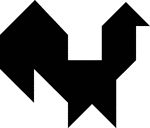
Rooster
Tangrams, invented by the Chinese, are used to develop geometric thinking and spatial sense. Seven figures…

Rooster
Tangrams, invented by the Chinese, are used to develop geometric thinking and spatial sense. Seven figures…
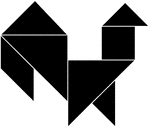
Rooster
Tangrams, invented by the Chinese, are used to develop geometric thinking and spatial sense. Seven figures…

Rooster
Tangrams, invented by the Chinese, are used to develop geometric thinking and spatial sense. Seven figures…
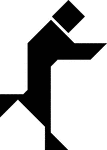
Runner
Tangrams, invented by the Chinese, are used to develop geometric thinking and spatial sense. Seven figures…

Runner
Tangrams, invented by the Chinese, are used to develop geometric thinking and spatial sense. Seven figures…
